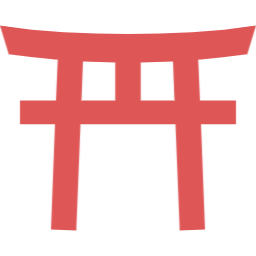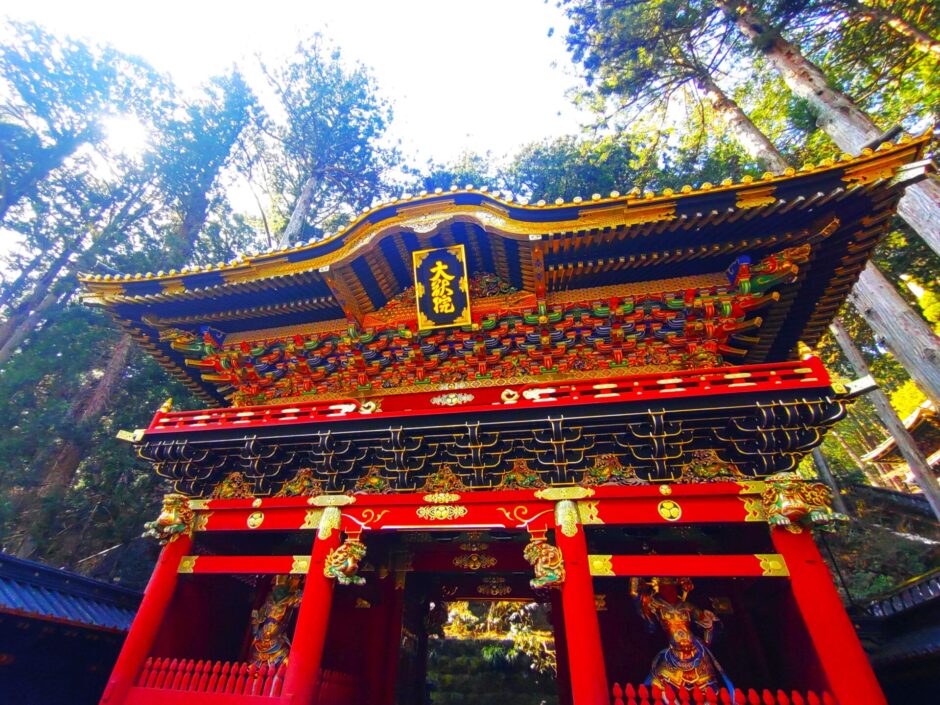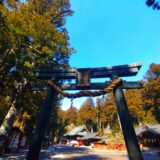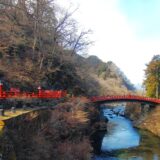目次
- 【Nikkozan Rinnoji Temple summary】
- 【Nikkozan Rinnoji Temple Bronze statue of Shodo Shonin】
- 【Nikkozan Rinnoji Temple Sanbutsu-do (Three Buddha Halls)】
- 【Nikkozan Rinnoji Temple Sorinto】
- 【Nikkozan Rinnoji Temple five-storied pagoda】
- 【Nikkozan Rinnoji Temple Yakushido】
- 【Nikkozan Rinnoji Temple Taiyuin】
- 【Nikkozan Rinnoji Temple Taiyuin Niomon】
- 【Nikkozan Rinnoji Temple Taiyuin Omizuya】
- 【Nikkozan Rinnoji Temple Taiyuin Nitenmon】
- 【Nikkozan Rinnoji Temple Taiyuin Yashamon】
- 【Nikkozan Rinnoji Temple Taiyuin Karamon】
- 【Nikkozan Rinnoji Temple Taiyuin Honden(Main Hall)】
- 【Nikkozan Rinnoji Temple and Taiyuin Nearby attractions】
- 【Nikkozan Rinnoji Temple and Taiyuin Access】
- Manager’s Comments
- Nikkozan Rinnoji Temple and Taiyuin
【Nikkozan Rinnoji Temple summary】
Rinnoji Temple was founded in 766 (Tempyo Jingo 2) during the Nara Period. The temple prospered under the patronage of the Tokugawa family. Many valuable architectural structures and Buddhist statues, including national treasures and important cultural properties, remain, such as the Taiyuin mausoleum enshrining the third Tokugawa Shogun, Iemitsu, and the Sanbutsudo, the main hall of the temple. After the Shinto/Buddhist Separation Order of the early Meiji period (1868), “Ni-sha-ichiji” together with Toshogu Shrine and Futaarasan Shrine were registered as “Shrines and Temples of Nikko” on the UNESCO World Cultural Heritage List. Until modern times, they were collectively called “Nikko-yama” (Mt. Nikko).
Three statues of Buddha are enshrined: Senju Kannon (Mt. Nantai), Amida Nyorai (Mt. Meoto), and Matou Kannon (Mt. Taroyama).
【Nikkozan Rinnoji Temple Bronze statue of Shodo Shonin】
![Nikkozan Rinnoji Temple and Taiyuin [Tochigi] DSC 1941 1024x768 - Nikkozan Rinnoji Temple and Taiyuin [Tochigi]](https://japan-shrine.info/wp-content/uploads/DSC_1941-1024x768.jpg)
It stands like a gatekeeper on the way to Rinnoji Temple. The temple was erected in 1955 to commemorate the establishment of Nikko as a city.
【Nikkozan Rinnoji Temple Sanbutsu-do (Three Buddha Halls)】
The World Heritage Site, the main hall itself is free to visit, but you can enter the main hall by paying an admission fee. There are three types of entrance fees: 400 yen for the Sanbutsu-do Hall, 550 yen for the Taiyuin, and 300 yen for the Treasure House and Shoyoen, with a set fee of 1,000 yen.
![Nikkozan Rinnoji Temple and Taiyuin [Tochigi] DSC 1945 1024x768 - Nikkozan Rinnoji Temple and Taiyuin [Tochigi]](https://japan-shrine.info/wp-content/uploads/DSC_1945-1024x768.jpg)
The main hall, Sanbutsu-do, is the largest wooden structure in eastern Japan. Inside the hall, the three main deities, Yakushi Nyorai, Amida Nyorai, and Shaka Nyorai, are enshrined as the three principal deities of Nikko Sanjo-gongen. Please note that photography is not allowed inside.
【Nikkozan Rinnoji Temple Sorinto】
![Nikkozan Rinnoji Temple and Taiyuin [Tochigi] DSC 1952 1024x768 - Nikkozan Rinnoji Temple and Taiyuin [Tochigi]](https://japan-shrine.info/wp-content/uploads/DSC_1952-1024x768.jpg)
The Sorintō, a symbol of the stupa, is said to have originated as an umbrella superimposed over the stupa, a mound containing the remains (stupa) of the founder of Buddhism, Sakyamuni Buddha. The Sorin-na of Rinnoji Temple was built in the Edo period (1603-1867) and is designated as a National Important Cultural Property. It is approximately 15 meters high and weighs an estimated 17 tons.
【Nikkozan Rinnoji Temple five-storied pagoda】
The pagoda was built in 1650, but was destroyed by fire due to lightning. The present pagoda was rebuilt in 1818. The pagoda’s roof structure, which does not use nails, is an impressive example of ancient Japanese architectural techniques. It is now designated as a National Important Cultural Property.
![Nikkozan Rinnoji Temple and Taiyuin [Tochigi] DSC 1962 1024x768 - Nikkozan Rinnoji Temple and Taiyuin [Tochigi]](https://japan-shrine.info/wp-content/uploads/DSC_1962-1024x768.jpg)
The suspended central pillar in the center of the tower is suspended from the four-story section to isolate it from vibration, and this system is also applied to the Tokyo Sky Tree because of its superior earthquake resistance.
![Nikkozan Rinnoji Temple and Taiyuin [Tochigi] DSC 1684 2 160x160 - Nikkozan Rinnoji Temple and Taiyuin [Tochigi]](https://japan-shrine.info/wp-content/uploads/DSC_1684-2-160x160.jpg) Tokyo SkyTree [Tokyo]
Tokyo SkyTree [Tokyo]
Next to the five-story pagoda is the Niomon Gate to Nikko Toshogu Shrine.
【Nikkozan Rinnoji Temple Yakushido】
In the Yakushido, Yakushi Ruriko-nyorai and the Twelve Divine Generals are enshrined. Each of the Twelve Divine Generals is said to be in charge of a particular zodiac sign, and you can see their faces up close.
![Nikkozan Rinnoji Temple and Taiyuin [Tochigi] 2025 03 23 16 36 Office Lens 1024x763 - Nikkozan Rinnoji Temple and Taiyuin [Tochigi]](https://japan-shrine.info/wp-content/uploads/2025_03_23-16_36-Office-Lens-1024x763.jpg)
There is a “Naruki-ryu” on the ceiling with a guide explaining and performing with a “clapper”. The Nikko Toshogu Shrine ticket includes this place, so why not experience this mysterious phenomenon? *The guide will explain in both Japanese and English.
【Nikkozan Rinnoji Temple Taiyuin】
![Nikkozan Rinnoji Temple and Taiyuin [Tochigi] DSC 2076 1024x768 1 - Nikkozan Rinnoji Temple and Taiyuin [Tochigi]](https://japan-shrine.info/wp-content/uploads/DSC_2076-1024x768-1.jpg)
Taiyuin is the tomb of the third Tokugawa Shogun “Iemitsu”. It was built in 1653. According to his last will and testament, Ieyasu Ieyasu, who was the grandfather of Tokugawa Shogun Iemitsu, had no intention of surpassing Toshogu, his grand father’s shrine, and the shrine is built in gold and black, with a stately and serene appearance that is beautifully different from Nikko Toshogu. As a reminder, Toshogu is a shrine, while Taiyuin is a temple, so no Kashiwa-mate (clapping hands) is performed.
【Nikkozan Rinnoji Temple Taiyuin Niomon】
After passing through the reception area, there is a gate guarded by two bright red Kongo statues.
![Nikkozan Rinnoji Temple and Taiyuin [Tochigi] DSC 2069 1024x768 - Nikkozan Rinnoji Temple and Taiyuin [Tochigi]](https://japan-shrine.info/wp-content/uploads/DSC_2069-1024x768.jpg)
Two statues of Vajrayaksa, Mijaku Vajrayaksa (an open-mouthed form) and Narayen Vajrayaksa (a closed-mouthed form), are enshrined in the temple, which is meant to protect the mausoleum from Buddhist enemies. The temple was built in the early Edo period and is designated as a National Important Cultural Property.
【Nikkozan Rinnoji Temple Taiyuin Omizuya】
![Nikkozan Rinnoji Temple and Taiyuin [Tochigi] DSC 2104 1024x768 - Nikkozan Rinnoji Temple and Taiyuin [Tochigi]](https://japan-shrine.info/wp-content/uploads/DSC_2104-1024x768.jpg)
It is a gorgeous structure, a hand-watering bucket in a Shinto shrine. There is a small waterfall behind it, and it seems that water is drawn into the water trough through a gutter.
【Nikkozan Rinnoji Temple Taiyuin Nitenmon】
![Nikkozan Rinnoji Temple and Taiyuin [Tochigi] DSC 2077 1024x768 - Nikkozan Rinnoji Temple and Taiyuin [Tochigi]](https://japan-shrine.info/wp-content/uploads/DSC_2077-1024x768.jpg)
There is the Nitenmon Gate, which enshrines two heavenly deities, Jikokuten on the left and Zocho-ten on the right. This huge gate is approximately 11.6 m high and 9.6 m wide. It is said to be the largest gate in Nikko Nichi-sha-ichiji, surpassing the Yomeimon Gate.
![Nikkozan Rinnoji Temple and Taiyuin [Tochigi] DSC 2099 1 1024x768 - Nikkozan Rinnoji Temple and Taiyuin [Tochigi]](https://japan-shrine.info/wp-content/uploads/DSC_2099-1-1024x768.jpg)
In accordance with the will of his grandfather, “Lord Ieyasu” (Toshogu), who did not want the shrine to be surpassed, it is built in gold and black, with a stately and serene structure, and has a beauty different from that of Nikko Toshogu.
【Nikkozan Rinnoji Temple Taiyuin Yashamon】
The Yashamon is the third gate of the Taiyuin, which serves as the entrance to the center of the mausoleum. It protects the mausoleum where Tokugawa Iemitsu is laid to rest, and four yasha are seated there.
![Nikkozan Rinnoji Temple and Taiyuin [Tochigi] DSC 2079 1024x768 - Nikkozan Rinnoji Temple and Taiyuin [Tochigi]](https://japan-shrine.info/wp-content/uploads/DSC_2079-1024x768.jpg)
The four nightshades are called “Four Protector Deities”, heavenly deities who protect Buddhism and Buddhists.
![Nikkozan Rinnoji Temple and Taiyuin [Tochigi] DSC 2081 1024x768 - Nikkozan Rinnoji Temple and Taiyuin [Tochigi]](https://japan-shrine.info/wp-content/uploads/DSC_2081-1024x768.jpg)
White is “Kendara” and protects the direction of the west, red is “Bidara” and protects the direction of the south, blue is “Umarokya” and protects the direction of the east, and green is “Abatmara” and protects the direction of the north.
【Nikkozan Rinnoji Temple Taiyuin Karamon】
![Nikkozan Rinnoji Temple and Taiyuin [Tochigi] DSC 2085 1024x768 - Nikkozan Rinnoji Temple and Taiyuin [Tochigi]](https://japan-shrine.info/wp-content/uploads/DSC_2085-1024x768.jpg)
It is an elaborate structure with a less flashy appearance, and looks more luxurious than the Karamon gate of Toshogu Shrine.
![Nikkozan Rinnoji Temple and Taiyuin [Tochigi] DSC 2088 1024x767 - Nikkozan Rinnoji Temple and Taiyuin [Tochigi]](https://japan-shrine.info/wp-content/uploads/DSC_2088-1024x767.jpg)
Since Tokugawa Iemitsu was born in the year of the dragon, it is decorated with intricate carvings including a white dragon.
【Nikkozan Rinnoji Temple Taiyuin Honden(Main Hall)】
![Nikkozan Rinnoji Temple and Taiyuin [Tochigi] DSC 2090 1024x768 - Nikkozan Rinnoji Temple and Taiyuin [Tochigi]](https://japan-shrine.info/wp-content/uploads/DSC_2090-1024x768.jpg)
The National Treasure “Worship Hall, Ai-no-Ma, and Main Hall” is a mausoleum (graveyard) dedicated to the third Shogun “Tokugawa Iemitsu”. The entire building shines in gold and is also called “Kinkakuden” (Golden Pavilion).
![Nikkozan Rinnoji Temple and Taiyuin [Tochigi] DSC 2091 1024x768 - Nikkozan Rinnoji Temple and Taiyuin [Tochigi]](https://japan-shrine.info/wp-content/uploads/DSC_2091-1024x768.jpg)
【Nikkozan Rinnoji Temple and Taiyuin Nearby attractions】
Shinbashi Bridge, Nikko Toshogu Shrine, Nikko Futarasan jinja Shrine, Takio Shrine, Rutsuman-gafuchi and Jiunji Temple
【Nikkozan Rinnoji Temple and Taiyuin Access】
Manager’s Comments
Although it is said that the “Taiyuin” was modestly built in consideration of Tokugawa Ieyasu, who was enshrined in Nikko Toshogu, it was gorgeous enough, and the gate and buildings were lined with very finely carved sections. Personally, I preferred the calm splendor of “Taiyuin” to that of “Toshogu”. Many people may be satisfied with Nikko Toshogu Shrine, but I think you should definitely visit Nikko Futarasan Shrine and Taiyuin as well.
2300 Yamauchi, Nikko-shi, Tochigi 321-1494
※Paid parking available.
 Tour of Japanese shrines and temples
Tour of Japanese shrines and temples 

![Nikkozan Rinnoji Temple and Taiyuin [Tochigi] DSC 2017 520x300 - Nikkozan Rinnoji Temple and Taiyuin [Tochigi]](https://japan-shrine.info/wp-content/uploads/DSC_2017-520x300.jpg)
![Nikkozan Rinnoji Temple and Taiyuin [Tochigi] DSC 1936 520x300 - Nikkozan Rinnoji Temple and Taiyuin [Tochigi]](https://japan-shrine.info/wp-content/uploads/DSC_1936-520x300.jpg)
![Nikkozan Rinnoji Temple and Taiyuin [Tochigi] DSC 2034 520x300 - Nikkozan Rinnoji Temple and Taiyuin [Tochigi]](https://japan-shrine.info/wp-content/uploads/DSC_2034-520x300.jpg)
![Nikkozan Rinnoji Temple and Taiyuin [Tochigi] DSC 2153 520x300 - Nikkozan Rinnoji Temple and Taiyuin [Tochigi]](https://japan-shrine.info/wp-content/uploads/DSC_2153-520x300.jpg)
![Nikkozan Rinnoji Temple and Taiyuin [Tochigi] DSC 2119 520x300 - Nikkozan Rinnoji Temple and Taiyuin [Tochigi]](https://japan-shrine.info/wp-content/uploads/DSC_2119-520x300.jpg)
![Nikkozan Rinnoji Temple and Taiyuin [Tochigi] d03f4895144a9edffd2e421dec93d4a8 - Nikkozan Rinnoji Temple and Taiyuin [Tochigi]](https://japan-shrine.info/wp-content/uploads/sng/d03f4895144a9edffd2e421dec93d4a8.png)
![Nikkozan Rinnoji Temple and Taiyuin [Tochigi] DSC 2017 150x150 - Nikkozan Rinnoji Temple and Taiyuin [Tochigi]](https://japan-shrine.info/wp-content/uploads/DSC_2017-150x150.jpg)
![Nikkozan Rinnoji Temple and Taiyuin [Tochigi] DSC 2034 150x150 - Nikkozan Rinnoji Temple and Taiyuin [Tochigi]](https://japan-shrine.info/wp-content/uploads/DSC_2034-150x150.jpg)
![Nikkozan Rinnoji Temple and Taiyuin [Tochigi] DSC 2153 150x150 - Nikkozan Rinnoji Temple and Taiyuin [Tochigi]](https://japan-shrine.info/wp-content/uploads/DSC_2153-150x150.jpg)
![Nikkozan Rinnoji Temple and Taiyuin [Tochigi] DSC 2119 150x150 - Nikkozan Rinnoji Temple and Taiyuin [Tochigi]](https://japan-shrine.info/wp-content/uploads/DSC_2119-150x150.jpg)

